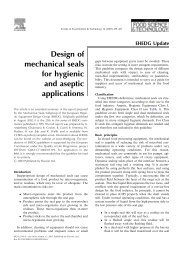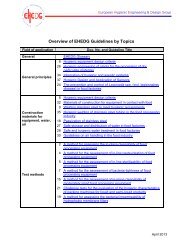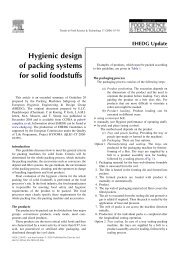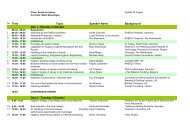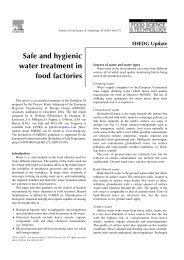Yearbook 2013/2014 - ehedg
Yearbook 2013/2014 - ehedg
Yearbook 2013/2014 - ehedg
You also want an ePaper? Increase the reach of your titles
YUMPU automatically turns print PDFs into web optimized ePapers that Google loves.
Flow behaviour of liquid jets impinging on vertical walls 67<br />
by the falling film. Soil in this region will be removed by the<br />
action of detergent and lower shear stresses, as reported<br />
by Morison and Thorpe (2002). 1 Under some conditions<br />
the falling film will narrow below the impingent plane and<br />
give poor contact with the soil, as shown in Figure 2 (b). It is<br />
therefore important to be able to predict the transition from<br />
the wide, gravity, film flow behaviour to the narrow, rivulet<br />
regime.<br />
Predicting the film jump<br />
A model for the film jump has recently been developed. 2 This<br />
allows R to be predicted from<br />
¼<br />
⎡ m 3 ⎤<br />
R = 0.276 ⎢ ⎯⎯⎯⎯⎯⎯ ⎥<br />
⎣ μργ(1− cos b) ⎦<br />
(1)<br />
In this equation, m is the jet mass flow rate; μ is the viscosity<br />
of the liquid and ρ is its density; γ is the surface tension, and<br />
β is the contact angle of the liquid on the substrate.<br />
Figure 3 shows good agreement between experimental<br />
data and the model for water on Perspex. Nozzle sizes, d N<br />
,<br />
typical of those used in industrial practice have been tested.<br />
Comparison with other data sets, including those reported<br />
in Morison and Thorpe (2002), are reported in Wilson et al.<br />
(2011) and Wang et al. (<strong>2013</strong>). 1–3<br />
surfactant molecules had time to collect at the solid/liquid/air<br />
interface, gave poor agreement with the measured values.<br />
This indicates that dynamic surface tension effects are<br />
important in these flows.<br />
A second important finding reported in Wang et al. (<strong>2013</strong>)<br />
is that at higher flow rates and with larger nozzles, R was<br />
independent of the nature of the substrate. This indicates<br />
a change in the phenomena controlling the flow pattern at<br />
higher flow rates from one controlled mainly by interfacial<br />
forces to one where fluid inertia become important. Using<br />
a contact angle of 90° in Equation (1) gave reasonable<br />
predictions for R in these cases.<br />
Predicting the film width<br />
The relationship between W and R cannot be obtained using<br />
the simple models behind Equation (1). Measurements of<br />
W (= 2Rc in Figure 3) indicate that Rc ≈ 2R at lower flow<br />
rates and approaches Rc ≈ 4/3R at higher flow rates. These<br />
empirical results allow W to be estimated.<br />
Falling film flow patterns<br />
The tendency to exhibit gravity or rivulet flow in the region<br />
below the impingement plane has been found to follow the<br />
criterion given by Hartley and Murgatroyd (1964) for the<br />
stability of wide falling liquid films. 4 This says that film will be<br />
stable if the wetting rate, defined as m/W, is larger than the<br />
critical value given by<br />
m<br />
⁄ W<br />
≥ 1.69 (μρ/g) 0.2 [γ(1− cos b)] 0.6 (2)<br />
Here g is the acceleration due to gravity. Equation (2) holds<br />
for vertical surfaces; for inclined walls, g is modified to<br />
account for the angle of slope.<br />
We have found that Equation (2) gives reasonable predictions<br />
of the transition from the gravity to rivulet regimes for these<br />
falling films. Equation (2) has also been found to apply for<br />
solutions containing a surfactant, using the values of γ and<br />
b obtained from equilibrium contact angle measurements.<br />
Surfactants which promote wetting on the soil or substrate<br />
will give smaller values of b and therefore, from Equation<br />
(2), reduce the flow rate required to avoid rivulet formation<br />
(as W is less sensitive to surfactant content).<br />
Figure 3. Comparison of experimental measurements of R with<br />
values predicted from Equation (1) for water on Perspex for<br />
different nozzle sizes and temperatures. Reproduced from Wang et<br />
al. (<strong>2013</strong>) with permission.<br />
Equation (1) shows that R is larger for liquids with a small<br />
contact angle (i.e., ones that wet the surface) and for liquids<br />
with a lower surface tension. Surfactants are often added<br />
to promote wetting and change the contact angle. Recent<br />
work has demonstrated that the effect of surfactants on<br />
R comes mainly through their influence on the surface<br />
tension. 3 Predictions of R using Equation (1) using contact<br />
angles measured under equilibrium conditions, where the<br />
Figure 4 shows an example for water jets impinging on a<br />
vertical glass wall. Solid symbols indicate that the falling film<br />
exhibited gravity flow, while open symbols denote rivulet flow<br />
behaviour.<br />
The data are plotted in terms of the Eötvös number, a<br />
dimensionless width, and a dimensionless flow rate, F, given<br />
by<br />
and<br />
Eo = ρgW 2 ⁄ γ (3)<br />
F = ρgm 2 ⁄ γμ2 (4)



